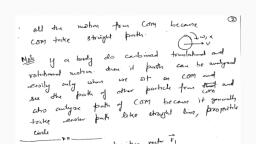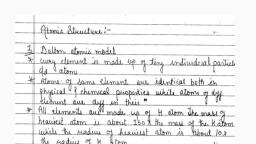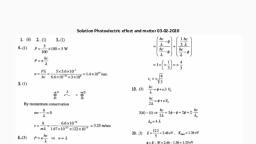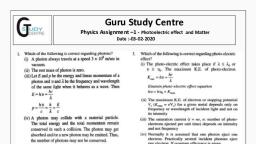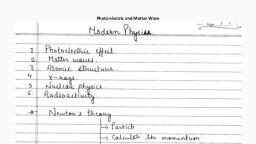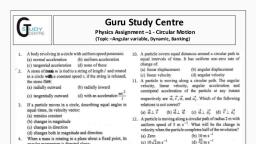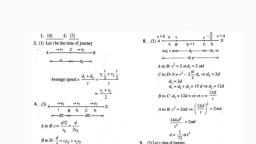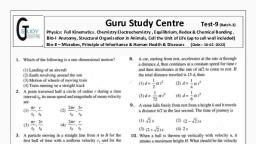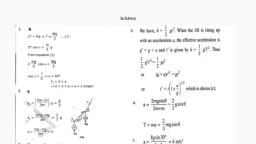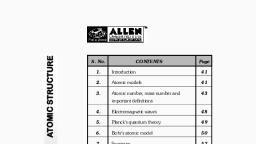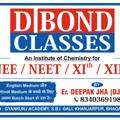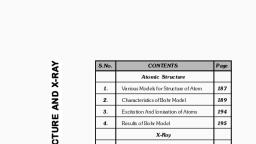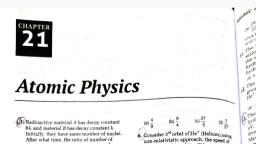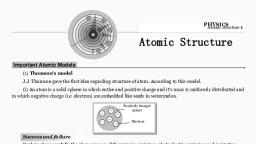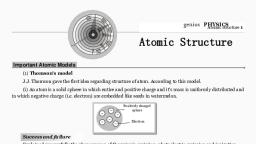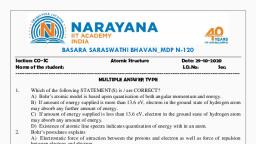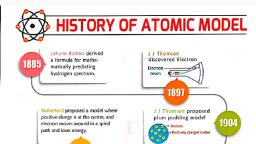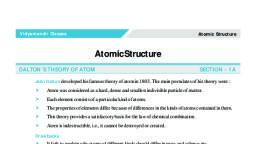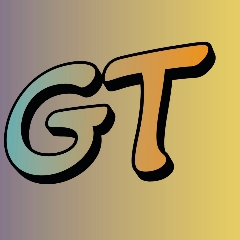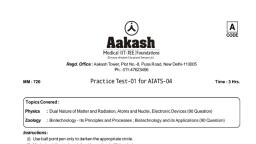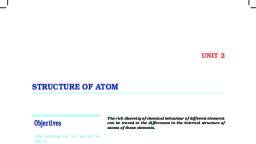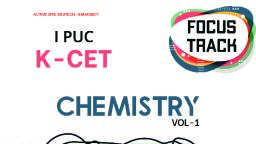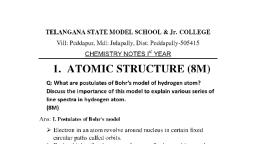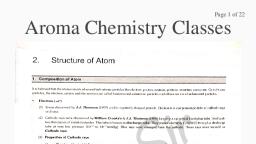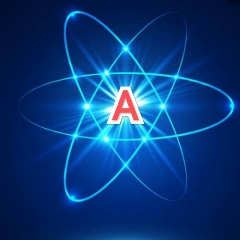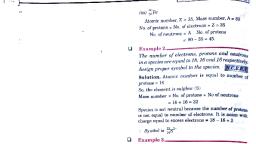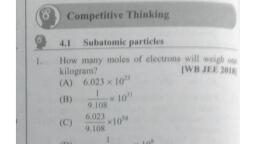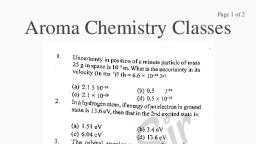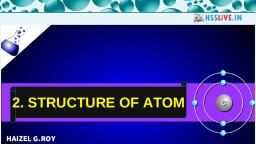Page 1 :
Guru Study Centre, SguDy, , CENTRE Physics Assignment —1 — Atomic Structure, Date :-06-02-2020, , , , , , , , , , , , , , , , , , 1. The plum pudding model of atom was proposed by 12.In Rutherford atom model, size of atomic nucleus is, (a) Einstein (b) Rutherford (a) 10-4 mto 10° m (b) 10! mto 10'S m, (c) Bohr (d) Thomson (c) 10-4 cm to 10-5 cm (d) 100-1000 fermi, ‘ e ‘ 13.The correct expression for distance of closest approach to gold, 2: The average angle of deflection of a-paticles by a thin gold foil of ths sha putes, predicted by Thomson's model is —, (a) much less (b) much more wee 227K 6) m= 222K, (c) about the same as predicted by Rutherford’s model of atom Lie?) dg, 3. The probability of backward scattering of a particles from gold 2 2, foil as predicted by Thomson model is 22, Ze? K?, (a) much ess (6) mach more ope Oe, (c) about the same as predicted by Rutherford’s atom model ym") 3m, 4.” Thomson atom model failed to explain 1A. The variation of number of alpha particles scattered at angle 0, (a) large angle scattering of a particles from the gold foil is correctly represented by, (b) origin of spectral lines in the spectrum of hydrogen atom ® é, (c) both (a) and (6), (d) neither (a) nor (b) N(6)| N(®), 5. Who introduced the concept of atomic nucleus ?, (a) Einstein (b) Bobr, () Thomson (d) Rutherford bees, 6. The total energy of electron orbiting around the nucleus in the —>6 — 8, ground state of the atom is © @, (a) zero (6) less than zero, (c) more than zero (d) cannot say N(®) N(6), 7. The angular momentum of electron in nth orbit is given by {, A, (@) nh ®) >, a — 6 —»0, © nh @ wh 15. For head on collision of an alpha particle with a gold nucleus,, 2n Qn ; impact parameter must be, 8. The charge on electron and proton is reduced to half. What will (a) infinite (0) zero, be the new value of Rydberg constant ? (c) maximum (d) minimum, (aR (b) RQ 16,. in a Rutherford scattering experiment, when a projectile of, (c) RI4 (d) RAG charge Z, and mass M, approaches a target nucleus of Charge Z,, 9. The total energy of an electron in the excited state corresponding Cae, =3isE. is the potential energy with proper sign ? ; 5, a i ()2E ™ Re ed, (b) Directly proportional to M, x M,, a @E i _, () -E - ( ‘ coos (¢) Directly proportional to Z, Z,, 10. The minimum energy in eV required to strip off 10 times ionized (a) Inversely proportional to Z,, Na atom (Z = 11) of its last electron is 17. Rutherford’s « ray scattering experiment concluded that, (a) 13-6 MeV (b) 136 x 1eV (a) electrons revolve around the nucleus, (c) 136x 1 eV (@) 136x 1b eV (b) electrons are scattered in space, 11. The orbital electron of the hydrogen atom jumps from ground (c) there is heavy mass at the centre of every atom, State to a higher energy state and its orbital velocity is reduced to (d) velocity of all electrons is same, one third of its initial value. If r is radius of orbit in ground state, 4, In Rutherford c@ ray scattering experiment, what will be the, what is the radius in the new orbit ? correct angle for a: scattering for an impact parameter b = 0 ?, (a) 2r () 9r @ (b) 90°, (3 @Ar (6) 180° @ m0, , , , GURU STUDY CENTRE (KACHERI ADDA, DHARAMSHALA DISTT. KANGRA) CONTACT US :- 8629073248,, 8988076292, 9882983453 EMAIL:- GURUSTUDY82@GMAIL.COM, WWW.GURUSTUDYCENTRE.COM
Page 2 :
19, Rutherford’s scattering experiment showed that every atom, contains, , (a) protons (b) neutrons (c) electrons (d)_ nucleus, 20. If number of o particles scattered at 90° angle is 56, then number, of o particles scattered at 60° will be, (a) 224 (b) 108 (c) 98 (d) 256, 21. The diagram shows in, Fig, 12.2.2, the path of se, four alpha particles of 2, same energy being 3 @, , by the nucleus of an atom, 4 ==, Which of there is not, , physically possible ?, (a) 3.and 4 (b) 2and 3, (c) land 4 (d) 4 only, , 22. The distance of closest approach of an © particle fired towards a, nucleus with momentum p is r, If the momentum of o particle is, 2 p, the corresponding distance of closest approach will be, (a) 2 ()2r () 4r (@) ri4, , 23. In Fig, 12.3.1, the energy levels of the hydrogen atom have been, shown along with some transitions marked A, B, C. The, transitions A, B and C respectively represent, , MME ESA., , 0.54 ev, ~0.85 ev, -LSlev, , , , n=5, , , , ne=4, n=3 2, , , , Cc, , , , , , B, n=2—}—_ 8 —__________-3.4ev, , A, , gpg Gy, , (a) the first member of the Lyman series, third member of, Balmer series and second member of Paschen series,, , (6) the ionisation potential of H, second member of Balmer, series and third member of Paschen series, , (c) the series limit of Lyman series, second member of Balmer, series and second member of Paschen series, , (d) the series limit of Lyman series, third member of Balmer, series and second member of Paschen series., , 24, A hydrogen atom in the ground state is excited by radiations of, wavelength 975 A. The energy state to which the atom is excited, is, (a) 1 2 ©3 @ 4, , 25, The first line of Balmer series has wavelength 6563 A. What will, be the wavelength of the first member of Lyman series ?, , (@) 1215-4A (6) 2500, (©) 7500 A (@ 600A, , 26, The wavelength of the first line of Lyman series for hydrogen, atom is equal to that of the second line of Balmer series for a, hydrogen like ion. The atomic number Z of hydrogen like ion is, (a)3 (b)4 (1 (a2, , 27, How many electrons are there in the M shell ?, , (a) 8 (b+) 18 = @) 32 (d) 2, , , , GURU STUDY CENTRE (KACHERI ADDA, DHARAMSHALA DISTT. KANGRA), 8988076292, 9882983453 EMAIL:- GURUSTUDY82@GMAIL.COM, WWW.GURUSTUDYCENTRE.COM, , 28. The wave number of radiation emitted when electron jump from, 4th orbit to 2nd orbit in hydrogen atom is 20497 cm™', Then the, wave number of radiation for same transition in helium is, , (a) 5099 cm! (&) 20497 cm-!, (c) 40994 cm! (d) $1988 m=, 29, Electron emits energy when shifting from, (a) lower orbit to higher orbit (b) higher orbit to lower orbit, (c) both of the above (d) none of the above., 30. Magnetic moment of Ne will be, (a) 0 () 127 x 10 Am?, , (©) 3410 Am? (@) 56x 10% Am?, , 31. If the series limit wavelength of the Lyman series for hydrogen, atom is 912 A, then the series limit wavelength for the Balmer, series for the hydrogen atom is, , (a) 912A (6) 912x2A, , 9, () 912x4A @ aA, , 32. The wavelength of first line of Balmer series is 6563 A. The, wavelength of first line of Lyman series will be, , (a) 1215A (6) 2500 A, , (0) 500A (4) 600A, , 33. The wavelength of the first line of Lyman series for hydrogen, atom is equal to that to the second line of Balmer series for a, hydrogen like ion. The atomic number Z of hydrogen like ion is, (a) 3 (4., , (1 (a 2, , 34, Electron in hydrogen atom first jumps from third excited state to, second excited state and then from second excited state to the, first excited state, The ratio of the wavelength 2; : Aa emitted in, the two cases is, , (a) 27/20 (6) 27/5, , (c) 207 (d) 7S ’, 35. The orbital frequency of an electron in hydrogen atom is, proportional to, , @i rm @ al @ wo, , 36, The quantum number corresponding to orbit of diameter 0.0001, mm in hydrogen atom will be (Given that radius of orbit with, n=1is051x 10! m), , (a) 39 () 31 © 9 (@) 49, , 37. An electron of a stationary hydrogen atom passes from the fifth, energy level to the ground level. The velocity that the atom, , acquires as a result of photon emission will be, 25hR 25m 24m 24bR, (a) he (6) aR © TER (d) Sm, , 38. Energy required for the electron excitation in Li** from the first, to the third Bohr orbit is, , (a) 122-4 eV (6) 121eV, (c) 363 eV (d) 108-8 eV, 39. Of the following transitions in the Hydrogen atom, the one which, gives an emission line of the highest frequency is, (a) n=3ton=10 (6) n=10ton=3, (c) n=lton=2 (d) n=2ton=1, 40, The transition from the state n = 4 ton = 3 in a hydrogen like atom, , results in ultraviolet radiation. Infrared radiation will be obtained, , (a) 231, () 432, , (b) 332, (dj 534, , CONTACT US :- 8629073248,, , , , in the transition from
Page 3 :
41. In a hydrogen atom, the electron in a given orbit has total energy, ~ 15 eV, The potential energy is, (a) 15eV (b) -1-5eV, (c) 30eV (d) -30eV, 42. Consider the spectral line resulting from the transition n = 2 to, n = 1 in the atoms and the ions given below. The shortest, wavelength is produced by, (a) Hydrogen atom (6) Deuterium atom, (c) Singly ionised helium (d) Doubly ionised lithium., 43, The ground state energy of hydrogen atom is ~ 1346 eV. What is, the potential energy of the electron in this, state ?, (a) OeV (b) =27,2eV, (c) Lev (d@) 2eV, 44, lonisation energy for hydrogen atom in the ground state is E., What is the ionisation energy of Li*** atom in the 2nd excited, state ?, @E (b) 3E, (©) 6E (d) 9E, 45. An electron in the hydrogen atom jumps from excited state n to, the ground state. The wavelength so emitted illuminates a, photosensitive material having work function 2:75 eV. If the, stopping potential of the photoelectron is 10 V, then the value of n, is, (a) 2 (b) 3 () 4 @) 5, 46, The transition from the state n = 3 to n= | in a hydrogen like atom, results in ultraviolet radiation. Infrared radiation will be obtained, in the transition from : :, (a2 31 (b)3 2, (42 (43, 47. The ground state energy of hydrogen atom is ~ 13-6 eV. What is, the potential energy of the electron in this state, (a) OeV (b) -272 eV, (ce) LeV (d@) 2eV, 48. The hydrogen atom can give spectral lines in the series, Lyman,, Balmer and Paschen. Which of the following statements is, correct ?, (a) Lyman series is in the infrared region, (b) Balmer series is in visible region (partly), (c) Balmer series is in the ultraviolet region, (d) Paschen series is in the visible region, 49. What is binding energy of hydrogen nucleus ?, (a) Zero (b) 13-6eV, (c) More than 13-6 eV (d) Infinite, 50, In which of the following systems will the radius of the first orbit, (n= 1) be minimum ?, (a) Singly ionized He (b) Deuterium atom, {c) Hydrogen atom (d) Doubly ionised Lithium stom, 51. Energy F of a hydrogen atom with principal quantum number n is, given by £= 3S ev The energy of photon ejected when he, , electron jumps from n = 3 state to n = 2 state of hydrogen is, approximately, (a) 0-85 eV, (c) 189eV, , () 34ev, @ 15eV, , GURU STUDY CENTRE (KACHERI ADDA, DHARAMSHALA DISTT. KANGRA), 8988076292, 9882983453 EMAIL:- GURUSTUDY82@GMAIL.COM, WWW.GURUSTUDYCENTRE.COM, , 52. The ionization energy of the electron in the hydrogen atom in its, ground state is 13-6 eV. The atoms are excited to higher energy, Jevels to emit radiations of 6 wavelengths. Maximum wavelength, of emitted radiation corresponds to the transition between, (a) n=3ton=I states (b) n=2ton=1 states, (c) n= 4 to q=3 states (d) n=3ton=2 states, , 53. Fig. 12.4.3 shows the energy levels for an electron in a certain, atom, Which transition shown in Fig. 12.4.3, represents the, , , , , , emission of a photon with the most energy, pond, rrr, = a=2, [ora, (a) 1 (0, (Ml @ Vv, , 54, Ratio of longest wavelengths corresponding to Lyman and Balmer, series in hydrogen spectrum is, , 9 5, o> o>, 3 1, OF @>5, 55.. Given the longest wavelength in Lyman series as 1240 A, the, highest frequency emitted in Balmer series is, (@) 8x 10! Hz (6) 8x10? Hz, (©) 8x10 Hz @) 8x10 He, , 56, . In the Balmer series of emission spectrum of hydrogen atom, the, line with the longest wavelength (= 656-3 nm) in red is called, , (@) Ha () Hp, , (© hy ( G, 57. , The unit of Rydberg constant is, , (a) bam (b) candela, , st (d) me, , 58. A beam of fast moving alpha particles were directed ~, towards a thin film of gold. The parts A’, B’ and C’ of, the transmitted and reflected beams corresponding to the, incident parts A, B and C of the beam, are shown in the, adjoining diagram. The number of alpha particles in, , f *, , c, Cc, , (1) B’ will be minimum and in C’ maximum, (2) A’ will be maximum and in B’ minimum, (3) A’will be minimum and in B’ maximum, (4) C’ will be minimum and in B’ maximum, , 59. An a-particle of 5 MeV energy strikes with a stationary, nucleus of uranium at an scattering angle of 180°. The, nearest distance upto which @-particle reaches the nucleus, will be of the order of, , (2) 10cm, , (4) 10° em, , (iA, (3) 10" cm, , CONTACT US :- 8629073248,
Page 4 :
61., , 62., , 63., , In Rutherford scattering experiment, what will be the, , correct angle for @ scattering for an impact parameter, , b=0 (AIPMT 1994), , (1) 90° (2) 270° (3) 0° (4) 180°, , Which of the following is correct regarding Bohr’s theory, , for hydrogen like atoms in n” orbit, , (i) Time period: T, = =, , (ii) K, =-E,; U, = 2,, , payee Zz a, , Gi) re Sin, aT FE, , (iv) Angular momentum is independent of Z, , (1) (i), Gi), (ii) (2) (i), Gi), (iv), , (3) (i), (iii), (iv) (4) all, , In the Bohr model of the atom, , (i) the radius of the n™ orbit is proportional to n*, , (ii) the total energy of the electron in n" orbit is inversely, proportional to n, , (iii) the angular momentum of the electron in an orbit is, an integral multiple of h/2x, , (iv) the magnitude of the P.E. of the electron in an orbit is, > its KE., , (1) (i), (ii), (ii) (2) (i), (ii), (iv), , (3) (i), (ii), (ii) (4) all, , The minimum orbital angular momentum of the electron, , in a hydrogen atom is, , (Mh (2) hi2, , (3) hn (4) Wa, , The energy of an atom (or ion) in its ground state is, -54.4 eV. It may be, , (1) hydrogen (2) deuterium, , (3) He* (4) Li*, , According to Bohr's theory, the ratio of the times taken, by the electron in a hydrogen atom to complete one, revolution in orbits corresponding to ground and first, excited states is, (1:4 (2)4:1, (3)1:8 (4) 8:1, The radius of the shortest orbit in a one-electron system is, 18 pm. It may be, (1) hydrogen (2) deuterium, (3) He* (4) Li*, Which of the following curves may represent the speed, of the electron in a hydrogen atom as a function of the, principal quantum number n?, (ja (2b y, GB)e (4)d, , , , =n, The ratio of the speed of the electron in the ground state, of hydrogen to the speed of light in vacuum is, , 1 2 2, = (2) — @:—, ws Q oa, , |, 3) —, O37 137, , 71,, , 72., , 73,, , 74., , 75., , GURU STUDY CENTRE (KACHERI ADDA, DHARAMSHALA DISTT. KANGRA), 8988076292, 9882983453 EMAIL:- GURUSTUDY82@GMAIL.COM, WWW.GURUSTUDYCENTRE.COM, , Which of the following statements about the Bohr model, , of the hydrogen atom is false, , (1) Acceleration of electron in n = 2 orbit is less than that, in n= | orbit, , (2) Angular momentum of electron in n = 2 orbit is more, than that in n = 1 orbit, , (3) Kinetic energy of electron in n = 2 orbit is less than, that in n = 1 orbit, , (4) Potential energy of electron in n = 2 orbit is less than, that inn = 1 orbit, , . Let A, be area enclosed by the n™ orbit in a hydrogen, , atom. The graph of nt v/s In(n), , (i) will pass through the origin, (ii) will be a straight line with slope 4, (iii) will be a monotonically increasing nonlinear curve, (iv) will be a circle, (1) @), Gi) (2) Gi), (iii), (3) @), Gi) (4) Gi), Gv), Suppose an electron is attracted towards the origin by a, force k/r where ‘k’ is a constant and ‘r’ is the distance of, the electron from the origin. By applying Bohr model to, this system, the radius of the n™ orbit of the electron is, found to be ‘r," and the kinetic energy of the electron to, be ‘T,’. Then which of the following is true, (1) T, independent of, ren (2) Tet yp en, , n, , 1, Ot Olesen, n, ‘The electric potential between a proton and an electron is, given by V=VjIn—, where ris constant. Assuming, °, , Bohr’s model to be applicable, write variation of r, with, , n,n being the principal quantum number,, (ren (2) 7, Un, G)r,cn (4) rye Un?, , A hydrogen-like atom has one electron revolving around, a stationary nucleus. The energy required to excite the, electron from the second orbit to the third orbit is 47.2 eV., , ‘The atomic number of the atom is, (D3 (2) 4, @3)5 (4) 6, , If the electron in a hydrogen atom jumps from the, third orbit to the second orbit, the emitted radiation has, , wavelength (R is the Rydberg’s constant), 36 SR, pnd 2), , ® SR ® 36, 6 SR, , @) 3R @ 6, , The ionization potential of hydrogen is 13.6 V. The, energy required to remove an electron from the 2™ orbit, , of hydrogen is, ()3.4eV (2) 68eV, (3)27.2eV (4) 544eV, , CONTACT US :- 8629073248,
Page 5 :
76., , 77., , 82,, , GURU STUDY CENTRE (KACHERI ADDA, DHARAMSHALA DISTT. KANGRA), 8988076292, 9882983453 EMAIL:- GURUSTUDY82@GMAIL.COM, WWW.GURUSTUDYCENTRE.COM, , A hydrogen atom in ground state absorbs 10.2 eV of, , energy. The orbital angular momentum of the electron is, , increased by, , (1) 1.05 x 10 J-sec (2) 2.11 x 10™ J-sec, , (3) 3.16 x 10 F-sec (4) 4.22 x 10™ J-sec, , The electron in a hydrogen atom makes a transition, , from an excited state to the ground state. Which of the, , following statements is true, , (1) Its kinetic energy increases and its potential and total, energies decreases, , (2) Its kinetic energy decreases, potential energy increases, and its total energy remains the same, , (3) Its kinetic and total energies decrease and its potential, energy increases, , (4) Its kinetic, potential and total energies decrease, , In which of the following transitions the wavelength will, , be minimum?, , (I)n=Ston=4 (2) n=4ton=3, , 3)n=3ton=2 (4) n=2ton=1, , In which of the following systems will the wavelength, , corresponding to n = 2 ton = | be minimum?, , (1) hydrogen atom, , (2) deuterium atom, , (3) singly ionized helium, , (4) doubly ionized lithium, , In hydrogen atom, electron makes transition from n = 4 to, , n= 1. Recoil momentum of the H atom will be, , (1)3.4x107N-s (2) 68x 107” N-s, , (3)34x10N-s (4) 68x10 N-s, , Four lowest energy levels of H-atom are shown in the, figure. The number of possible emission lines would be, , 3 = @4 ———— F738, 5 46 ee, n=1, , ‘The wavelength of radiation emitted is Ay when an electron, jumps from the third to the second orbit of hydrogen, atom. If the electron jump from the fourth to the second, orbit of the hydrogen atom, the wavelength of radiation, emitted will be 6, , 16 20, () 350 Q) We @) 7 (4) is, , Energy levels A, B, C of a certain atom corresponding to, increasing values of energy, i.e. Ey < Ey < Eg. If Ay, Ay, A,are the wavelengths of radiations corresponding to the, transitions C to B, B to A and C to A respectively, which, of the following statements is correct, , 25, , , , , , , , , , , , , , , , c, A, 8, 4g Ay, A, . 4, Marth @ 4=, , B)Ay+AgtAg=0 (4) A= AZ A?, , 84. The ionisation potential of hydrogen atom is -13.6 eV. An, , 87., , electron in the ground state of a hydrogen atom absorbs a, photon of energy 12.75 eV. How many different spectral, lines can one expect when the electron make a downward, transition, , qd. Q)4, , (3)2 (4) 6, , Hydrogen atoms in ground states are excited by, monochromatic radiation of wavelength 975 A. The, number of lines in the resulting spectrum will be, , (1)3 (24, , (3)6 (4) 10, , Imaging an atom made for a proton and a hypothetical, particle of double the mass of the electron but having the, same charge as the electron. Apply the Bohr atom model, and consider all possible transition of the hypothetical, particle to the first excited level. The longest wavelength, photon that will be emitted has wavelength A (given in, terms of Rydberg constant R for the hydrogen atom), equal to, 9 36 18 4, eet — = (4) —, OR ae Osr O>, Light from a discharge tube containing hydrogen atoms, falls on the surface of a piece of sodium. The kinetic, energy of the fastest photoelectrons emitted from sodium, is 0.73 eV. The work function for sodium is 1.82 eV, (1) the energy of the photons causing the photoelectric, emission is 2.55 eV, (2) the quantum numbers of the two levels involved in the, emission of these photons are 2 and 4, (3) the change in the angular momentum of the electron, in the hydrogen atom in above transition is h/x, (4) all options are correct, Three photons coming from excited atomic hydrogen, sample are picked up, Their energies are 12.1 eV, 10.2eV, and 1.9 eV. These photons must come from, (1) a single atom, (2) two atoms, (3) three atoms, (4) either two atoms or three atoms, , The ratio of longest wavelength and the shortest, wavelength observed in the five spectral series of emission, spectrum of hydrogen is, , 4 525, I= Pay eae, M3 ers, (32s 900, , (4) 7, , The wavelength of the first line of Lyman series for, hydrogen atom is equal to that of the second line of, Balmer series for a hydrogen like ion. The atomic number, Z of hydrogen like ion is, , (D2 (2) 3, , (3)4 41, , CONTACT US :- 8629073248,



